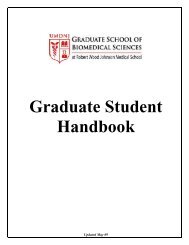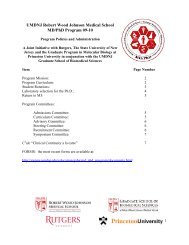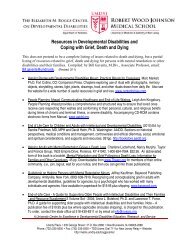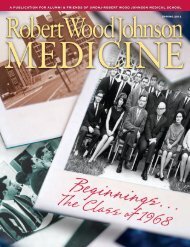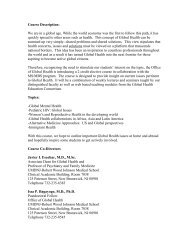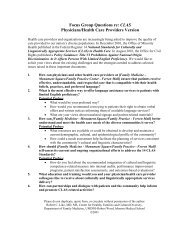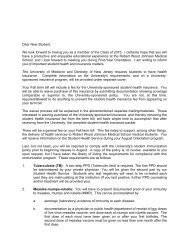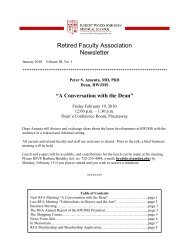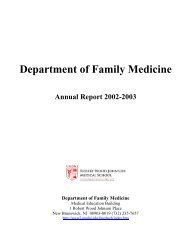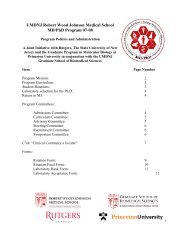Robert Wood Johnson Medicine • Spring 2011 • Population Science
Robert Wood Johnson Medicine • Spring 2011 • Population Science
Robert Wood Johnson Medicine • Spring 2011 • Population Science
You also want an ePaper? Increase the reach of your titles
YUMPU automatically turns print PDFs into web optimized ePapers that Google loves.
On her first day in the Emergency Department, Alexa Gale, MD, gets what she had hoped for: the opportunity to help care for patients whose symptoms do<br />
not necessarily add up to a clear diagnosis. At every step, Dr. Gale reports to Dr. Eisenstein, who helps her develop an evidence-based plan for each patient.<br />
➔ 2:40 P.M.: A new patient in<br />
Exam Room 3 has presented with<br />
nausea, vomiting, and abdominal<br />
pain. Four months ago, she had a<br />
gastric banding, a surgical procedure<br />
to promote weight loss. The patient<br />
has lost about 50 pounds but has not<br />
felt good since the surgery. Due to<br />
this and other complications, the<br />
band was subsequently removed.<br />
Dr. Gale asks the patient to precisely<br />
describe the pain (“Constant pressure?<br />
Radiating pain?”) and any other<br />
symptoms (“Any acid reflux?” “No”),<br />
then inquires about medications the<br />
patient takes and any diagnostic<br />
procedures she may have undergone<br />
(“Have you had an endoscopy?”<br />
“No”).<br />
➔ 2:45 P.M.: Dr. Gale excuses<br />
herself to take a phone call. The<br />
patient with MS will be admitted.<br />
The house physician will smooth<br />
her transition to the hospital and<br />
coordinate her care with a primary<br />
care physician.<br />
➔ 2:48 P.M.: Dr. Gale resumes<br />
taking the history of the patient who<br />
had the gastric band procedure.<br />
Her non-technical language — the<br />
urinary system is “the waterworks” —<br />
successfully puts the patient at ease.<br />
Dr. Gale asks permission to examine<br />
the patient’s abdomen and proceeds<br />
with the examination.<br />
Dr. Gale finds Dr. Eisenstein and<br />
reports on the details of the patient’s<br />
symptoms and medical history.<br />
They discuss the next steps. Dr. Gale<br />
mentions the possibility of postoperative<br />
complications, but<br />
Dr. Eisenstein redirects her: “Think<br />
about it more broadly. You’re thinking<br />
like a surgeon!” He is concerned the<br />
patient may have a bowel obstruction<br />
and suggests that Dr. Gale order an<br />
abdominal X-ray. When the X-ray does<br />
not show an obstruction, a CT scan<br />
is ordered, and a kidney stone is<br />
found. The patient begins to feel<br />
better, so she is discharged with a<br />
prescription for pain medication and<br />
referred to a urology group for outpatient<br />
evaluation.<br />
This partial log describes the first<br />
shift of Dr. Gale’s emergency medicine<br />
residency. In the year ahead, she will<br />
spend six months in the Emergency<br />
Department and a month each in<br />
anesthesia, obstetrics, dedicated<br />
trauma, and pre-hospital emergency<br />
medical services. By 2013, when she<br />
completes the residency program,<br />
she will be competent in every area of<br />
emergency medicine, including<br />
toxicology, pediatrics, administration,<br />
and research, and will have trained in<br />
every level of intensive care. M<br />
<strong>Robert</strong> <strong>Wood</strong> <strong>Johnson</strong> ■ MEDICINE 45



